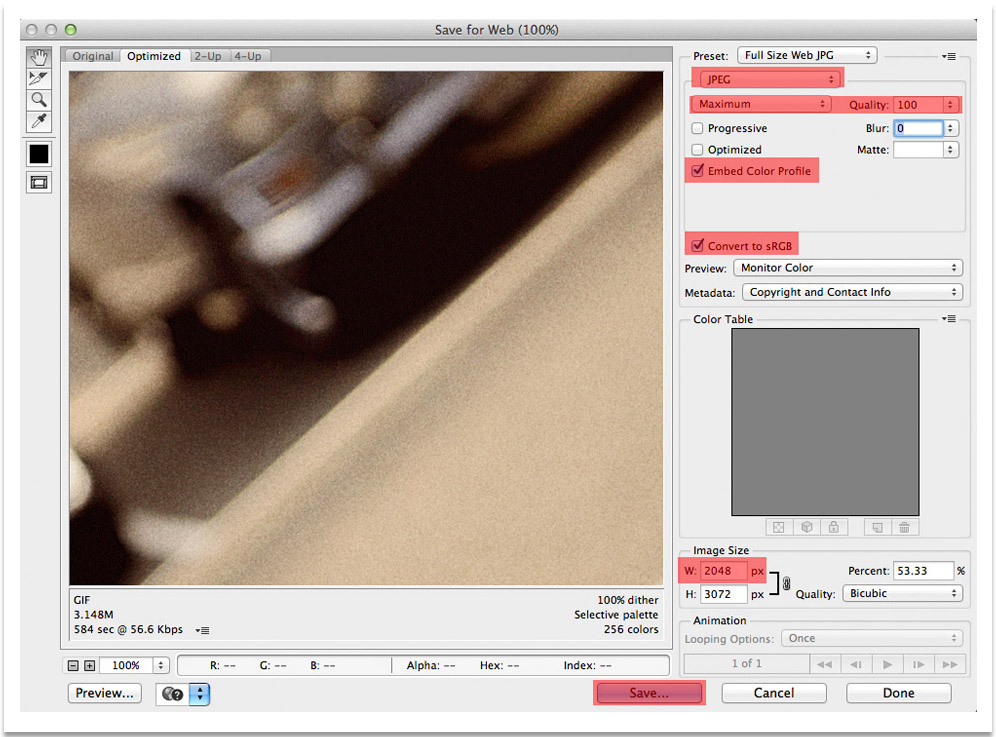What is covered
- Exporting from Lightroom to a specific size and colour space
- Converting to a specific colourspace in Photoshop
- Resizing an image in Photoshop
- Saving a JPG from Photoshop
Notes
- Always upload to the internet in sRGB
- Always work directly from RAW files in Lightroom or from PSD’s or Tiff’s in Photoshop – (Master Files)
- Only save to JPG’s, PNG’s or other “lossless” codecs when exporting to upload or print
- For cover photos, keep file size under 100kb to reduce Facebook compression
THEORY
Why does Facebook ruin my pictures?
People often complain that their photos look worse after uploading to Facebook and they would be correct. Colours can seem less impressive, it looks like you’ve lost detail in the picture and areas appear blocky but there are ways to optimise your files prior to uploading so that you can minimise the degradation and keep them looking as good as Facebook will let you.
There are three main reasons your images may look worse after uploading to Facebook; incorrect colour space, incorrect resolution and compression.
1. Colour Space
Colour spaces are hard to wrap your head around when first starting out but do some research and you should get on top of it in no time. I won’t go into the complexities of colour space here but basically the issue may be that you are shooting & editing in the “Adobe RGB 1998” colour space (or some version other version) and images online are displayed in an sRGB colour space. Shooting and editing in Adobe RGB 1998 is a good thing but when you come to upload your images to Facebook they will be converted to some version of the sRGB colour space. You have no control over how the colours are converted and you might find that the images you uploaded are less saturated or have slightly different hues than the picture you started with. To fix this you need to convert the colour space yourself either in Lightroom or Photoshop, before uploading.
2. Resolution
Facebook allows you to upload images of any size but has built in algorithms to automatically resize the image down to their maximum dimension of 2048px (longest side). This algorithm is not as nice as if you were to resize the photo yourself in either Photoshop or Lightroom and therefore will make your photo look worse when complete and perhaps lose detail and sharpness. The solution is simple, resize the picture before uploading to Facebook, it may even save you some upload time!
3. Compression
Facebook will automatically compress the images you upload to save space on their servers. The compression is somewhere equivalent to saving a JPG with the quality set to between 7 & 8. You can’t change this, all you can do is upload a JPG at the full quality of 12 to minimise the number of times your image is compressed, or use an uncompressed PNG for an slightly better result. If you compress your image to say a JPG 9 when you save it and then when you upload, Facebook recompresses your image to whatever it likes, you have now compressed the image twice, degrading the quality each time! Think of it like a photocopy, every time you make a copy of a copy it gets slightly worse. This is the same when saving compressed images (even at JPG 12). The solution is to work in a lossless format, such as PSD or TIFF (no compression) and only save a JPG or PNG once, at the end of your process, with the maximum quality setting possible.
PRACTICE
EXPORTING DIRECTLY FROM LIGHTROOM
Lightroom makes it very easy to convert profiles and resize the image, all from the export options.
1. With your photo/s selected, go up to File -> Export (Ctrl + Shift + E)
2. Go down to “File Settings” and select Image Format: JPEG Colour Space: sRGB and Quality 100 as shown in the picture below.
3. Under “Image Sizing” check the box that says “Resize to Fit” and select “Longest Edge” and type in “2048” “pixels” as the measurement with a resolution of “72” “pixels per inch“. You can select “Don’t Enlarge” to make sure that any images smaller than this size are not stretched to fit this dimension.
4. Hit export and you are done!

That should be easy enough but just incase here are some Lightroom Presets for exporting to different mediums. Please email me if you have any other mediums you would like added. Just unzip and copy the preset files to your Lightroom -> Export Presets -> User Presets folder.
Click here to download: Lightroom Export Presets
CONVERTING & SAVING FROM PHOTOSHOP
With your final image open in Photoshop go up to “File – Save For Web” (now under ‘File – Export – Save For Web’ from the July Photoshop CC update).
A box similar to the one below should be shown. You can select the “JPG High” preset as a base to start from but make sure all settings are as highlighted below, with your longest edge being 2048px (ideally you should size the photo to 2048px in PS first to retain the ideal sharpness, resizing steps described below). Or you can save a PNG file which will result in even less compression when uploaded to Facebook, although the file sizes will be much larger. I believe cover photos and profile pictures for Facebook pages will actually display a PNG file with less compression than a normal album/wall JPG if you upload as PNG. This is to allow crisp and sharp text for logos etc.
*Note in the image below, the height should be 2048px as it is the longest edge.

Click Save and you are done!
Alternatively these are the steps for sizing and converting images inside Photoshop:
Converting to sRGB Colour Space
1. With your final edited image open, go up to Edit -> Convert to Profile
2. On the Convert to Profile Screen, change the “Destination Space” to sRGB IEC61966-2.1. Leave the conversion options how they appear in the image below (you may want to select flatten image).
3. Click “OK” and your image will now be in the sRGB colour space. You may not be able to tell the difference visually but it will make all the difference when you upload.

*Any picture you upload online should be in sRGB, regardless of if it is Facebook, FlickR or 500px.
*If your source space already says “sRGB XXXXXXXXXX” then you are already working in sRGB and do not need to convert the file (you may want to look into changing your camera and photoshop settings so that you are working in Adobe RGB 1998).
Resizing The Image (Resolution)
1. With your image still open, go up to Image -> Image Size (Alt + Ctrl + I)
2. On the Image Size Screen, make sure the units are in “Pixels” and that the Width & Height boxes are linked with the chain icon. Change the longest edge to 2048 and leave the other edge at whatever is automatically calculated. Make sure the resolution is on 72 Pixels/Inch.

3. Click OK and your image is now optimised to the largest size currently handled by Facebook.
Compression (Saving)
You should be saving all of your images or ‘master files’ in a lossless file format such as TIFF or PSD. You should only save to a lossless codec such as JPG when you go to output for upload or printing etc. If you ever want to make any changes to a file you open up the master file and then save a new JPG.
1. With your file open, go to File -> Save As (Ctrl + Shift + S)
2. Change the “Save as type” to JPEG and make sure the ICC Profile is ticked on and click Save. (good housekeeping would be to add “_FB” to your filename so that you can instantly recognise what the file is for)

3. On the JPEG Options Screen make sure the Quality is set to 12, Maximum and Baseline (“Standard”) is checked.

4. Hit OK and you should now have an image optimised for Facebook.
CONCLUSION
Your images on Facebook are never going to look as good as viewing a full resolution PSD on a 4k monitor but by following the steps above you are doing everything you can to maximise the quality of your file on Facebook.
You can do this process for uploading to any website, all you have to do is find out what ideal size you should make your image for each website and change the resolution appropriately. As of July 2015 Instagram has increased their display size to 1080 x 1080 px (it used to display at 614 x 614 although I had read that 1936px was the recommended size for Instagram). So to export a file optimised for Instagram just change the maximum dimension 1080px instead of 2048px as we did for Facebook above. To go even further into optimising files you should actually change your sharpening depending on how large the image is going to be displayed. This is a little more complicated and I might cover this in a tutorial on sharpening at a later date.
Websites like 500px and FlickR are known for displaying better quality images (they will still have some compression etc.) so if Facebook doesn’t cut it for you try one of these services. You’ll find that many photographers post links to these pages from Facebook as opposed to uploading directly to FB.
I hope this was helpful, please send me any feedback, spelling mistakes or further questions you might have.

